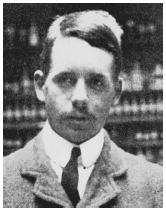Henry Moseley

ENGLISH PHYSICIST
1887–1915
Henry Moseley's research career lasted only forty months before tragically ending with his death on a Gallipoli battlefield in World War I. But in his classic study of the x-ray spectra of elements, he established the truly scientific basis of the Periodic Table by arranging chemical elements in the order of their atomic numbers.
Henry Gwyn Jeffreys Moseley, who was always called "Harry" by his family, was born in Weymouth, England, on November 23, 1887. His family was wealthy, aristocratic, and scientifically accomplished, and young Henry showed an early interest in zoology . He attended Eton on a King's scholarship, where he excelled in mathematics, and was introduced to the study of x rays by his physics teacher. He entered Trinity College, Oxford, in 1906. At that time, Oxford did not have a particularly notable science curriculum, but Moseley chose the school in order to be near his widowed mother. He graduated in 1910 with high honors in mathematics and science, and secured a position in the laboratory of Ernest Rutherford at the University of Manchester.
It was a time of great excitement and ferment in science, and Rutherford's laboratory was one of the epicenters of discovery in atomic physics. The first coherent theory of the structure of the atom was just then being developed by Rutherford and his research group, which, besides Moseley, included Niels Bohr, Hans Geiger, Kasimir Fajans, and others.
The nature of x rays was also receiving new interest because of the discovery by the German physicist Max von Laue in 1912 that they were diffracted by their passage through crystals and therefore possessed a wave nature. Succeeding experiments by William L. Bragg the same year showed that similar results could be obtained by the reflection of x rays from the face of a crystal. Moseley persuaded Rutherford to allow him and a colleague, C. S. Darwin, to further study the nature of x rays. Their work demonstrated that the spectral line of platinum, which they were using as the anticathode in their x-ray tube, was characteristic of that element alone. Moseley returned to Oxford, and despite the experimental deficiencies of his laboratories, measured the x-ray spectral lines of nearly all the elements from aluminum to gold. The results of his study showed a clear and simple progression of the elements that was based on the number of protons in the atomic nucleus, rather than the order based on atomic weights that was then the basis of the Periodic Table.
His work, called a "classical example of the scientific method," was the second and last of his independent publications. Despite the pleadings of his colleagues, he enlisted in the British Army at the outbreak of World War I, and was killed in battle on August 10, 1915.
SEE ALSO Bohr, Niels ; Bragg, William Lawrence ; Lanthanides ; Radiation ; Rutherford, Ernest .
Bartow Culp
Bibliography
Heilbron, J. L. (1966). "The Work of H. G. J. Moseley." Isis 57:336–366.
Heilbron, J. L. (1974). H. G. J. Moseley: The Life and Letters of an English Physicist, 1887–1915. Berkeley: University of California Press.
Jaffe, Bernard (1971). Moseley and the Numbering of the Elements. Garden City, NY: Doubleday.
Comment about this article, ask questions, or add new information about this topic: